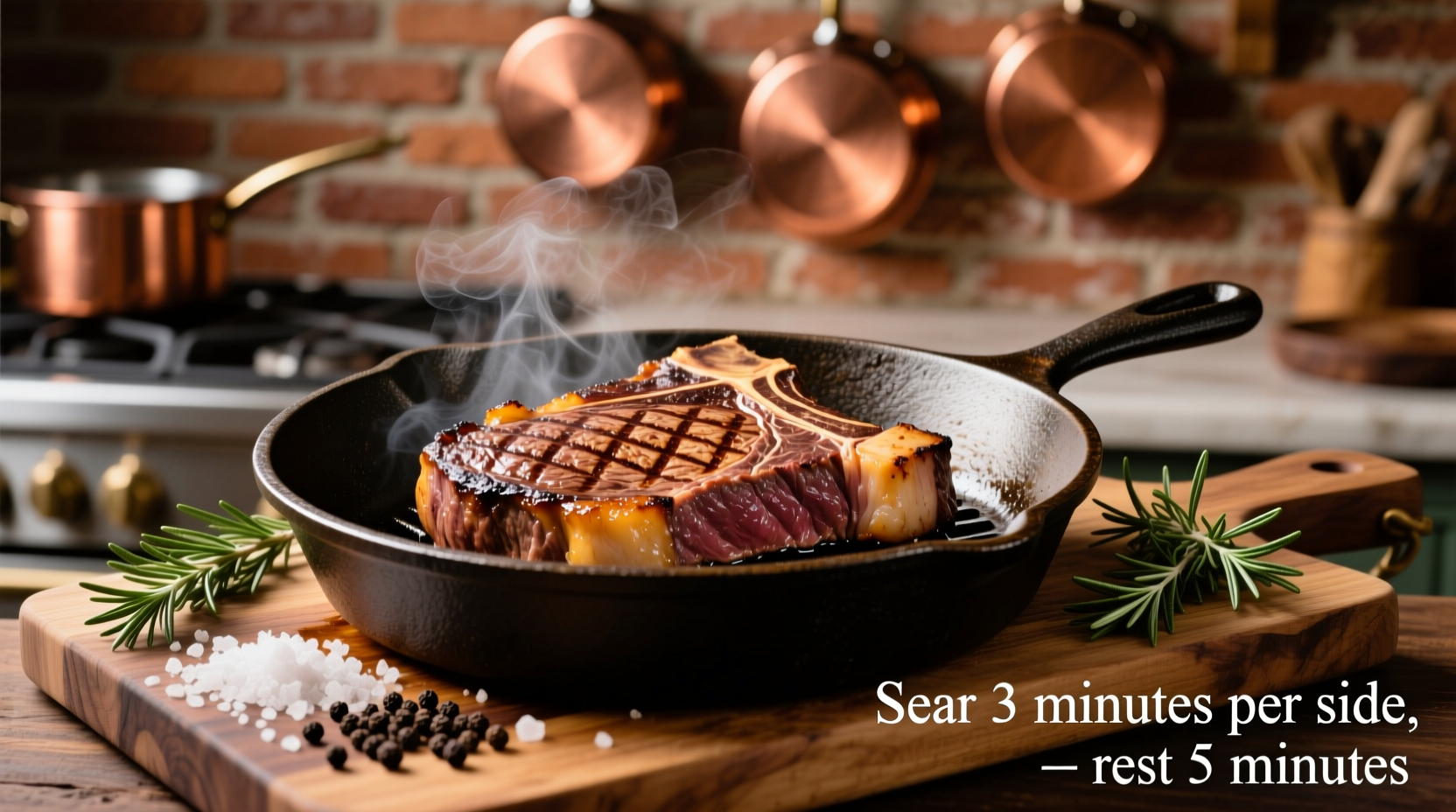Why Cast Iron Makes the Perfect Ribeye
Cast iron's superior heat retention creates an unparalleled sear that triggers the Maillard reaction - the chemical process responsible for that crave-worthy browned crust. Unlike stainless steel or non-stick pans, cast iron maintains consistent temperature when cold steak hits the surface, preventing the dreaded "steam instead of sear" scenario. Professional chefs consistently choose cast iron for steaks because it delivers reliable results even in home kitchens.
Your Essential Equipment Checklist
Before you begin, gather these critical items:
- 10-12 inch seasoned cast iron skillet (preheated 20 minutes)
- Ribeye steak (1.5 inches thick, preferably USDA Prime)
- High smoke point oil (avocado or grapeseed)
- Meat thermometer (instant-read recommended)
- Metal spatula (not silicone)
- Tongs for flipping
- Wire rack for resting
| Doneness Level | Internal Temperature | Visual Cues |
|---|---|---|
| Rare | 120-125°F | Cool red center |
| Medium Rare | 130-135°F | Warm red center |
| Medium | 140-145°F | Warm pink center |
| Medium Well | 150-155°F | Small pink center |
| Well Done | 160°F+ | No pink remaining |
Source: USDA Food Safety and Inspection Service Temperature Guidelines
The 7-Step Perfect Ribeye Method
Step 1: Proper Steak Preparation (45 Minutes Before Cooking)
Remove your ribeye from refrigeration 45 minutes before cooking. This critical step allows the steak to reach room temperature, preventing uneven cooking. Season generously with coarse kosher salt (1 teaspoon per pound) - the salt draws out moisture initially, then gets reabsorbed, seasoning the meat deeply while improving texture. Avoid pepper at this stage as it burns during searing.
Step 2: Skillet Preheating Protocol
Place your cast iron skillet on the stove over medium-high heat for 15-20 minutes. The skillet must reach 500°F for proper searing - test by sprinkling a few drops of water that should instantly vaporize and dance across the surface. Add 1 tablespoon of high smoke point oil just before adding the steak.
Step 3: The Searing Process (4-5 Minutes Per Side)
Place the ribeye in the skillet away from you to avoid oil splatter. Press gently with a metal spatula for full contact. After 2 minutes, rotate the steak 90 degrees to create cross-hatch sear marks. Cook undisturbed for another 2-3 minutes until a deep brown crust forms. Flip and repeat. For thicker cuts (over 1.5 inches), sear the edges by holding the steak vertically with tongs for 30-60 seconds per side.

Step 4: Butter Basting Technique
During the last 2 minutes of cooking, add 2 tablespoons butter, 2 crushed garlic cloves, and fresh thyme sprigs to the skillet. Tilt the pan and spoon the melted butter continuously over the steak for rich flavor infusion. This professional technique adds complexity without overpowering the beef's natural taste.
Step 5: Temperature Monitoring
Insert an instant-read thermometer horizontally into the thickest part of the steak. Remove from heat when 5°F below your target temperature (the steak will continue cooking while resting). For medium-rare, pull at 130°F. Never pierce the steak with a fork during cooking - use tongs to avoid juice loss.
Step 6: The Critical Resting Period
Transfer the steak to a wire rack (not a plate) and rest for 8-10 minutes. This allows juices to redistribute throughout the meat. Cutting too soon releases precious juices onto your plate. The internal temperature will rise 5-10°F during this period.
Step 7: Slicing and Serving
Slice against the grain at a 45-degree angle using a sharp carving knife. This shortens muscle fibers for maximum tenderness. Serve immediately with any accumulated resting juices spooned over the top.
Common Cast Iron Steak Mistakes to Avoid
Understanding these pitfalls prevents ruined steaks:
- Mistake: Cooking a cold steak
Solution: Always bring to room temperature first - Mistake: Moving the steak too soon
Solution: Wait until it releases naturally from the pan - Mistake: Using olive oil
Solution: Choose oils with smoke points above 400°F - Mistake: Skipping the rest period
Solution: Set a timer to avoid cutting too early
When Not to Use Cast Iron for Steak
While cast iron excels for most steak cooking, certain situations call for alternatives:
- Steaks thinner than 1 inch (use stainless steel for better control)
- When cooking multiple steaks (grill maintains consistent heat)
- Delicate fish steaks (non-stick prevents sticking)
- When precise low-temperature cooking required (sous vide better)
Perfect Pairings for Your Cast Iron Ribeye
Complement your steak with these classic accompaniments:
- Garlic mashed potatoes (absorbs delicious pan drippings)
- Roasted asparagus with lemon zest
- Simple arugula salad with balsamic
- Red wine reduction sauce made from deglazed pan











 浙公网安备
33010002000092号
浙公网安备
33010002000092号 浙B2-20120091-4
浙B2-20120091-4